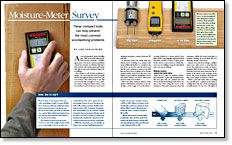Moisture-Meter Survey
These compact tools can help prevent the most common woodworking problems
Synopsis: The easiest way to see that your wood is dry enough is to use a moisture meter. Lon Schleining follows the work of wood scientist R. Bruce Hoadley as he explains how to check and manage moisture levels in rough lumber. His tips can prevent finishes that don’t stick, joinery that breaks apart, and boards that take on new and unwanted shapes. He talks about how to dry your wood and to what level of dryness. The article also takes a look at a dozen moisture meters to see which work best and which features you might want to consider.
As wood scientist R. Bruce Hoadley says, 90% of woodworking problems involve moisture. I couldn’t agree more. The most common problems caused by moisture are finishes that don’t stick, joinery that breaks apart and boards that take on new and unwanted shapes after milling.
The solution to all of these problems is simple: Use wood that has been properly dried to the right moisture content (see the story below). The easiest way to see that your wood is dry enough is to use a moisture meter. Using a moisture meter, I can be sure that wood I’m about to use is at its optimum moisture content: between 8% and 12%.
A moisture meter can really help you when you’re working on a project and need additional lumber to complete the job. How can you be sure the new stock has the same moisture content as the stuff that you have been working on for the last several weeks? And if you dry your own lumber, it goes without saying that a moisture meter will let you know when your stock is ready to be worked.
There are many moisture meters on the market, with features and prices to accommodate a wide range of woodworkers. I recently looked at a dozen priced from $60 to $350. I was happily surprised to find that their overall accuracy is quite good. So the choice comes down to which features you are willing to pay for and which ones you can do without.
Moisture meters come in two basic styles
There are two styles of moisture meters: pin and pinless. A pin-style moisture meter has two pins that are pushed into the wood. An electrical charge emits from one pin to the other, using the wood as the conductor. The meter measures electrical resistance within the board and gives a moisture reading. As wood dries, the conductivity changes (decreases).
Instead of an electrical charge, a pinless meter uses radio waves to penetrate the wood. The radio waves create an electromagnetic field. As the waves bounce back from the wood, the meter measures the reaction of the waves to the moisture in the wood. The meter translates this behavior into a percentage of moisture content.
From Fine Woodworking #156
For the full article, download the PDF below:
Fine Woodworking Recommended Products

Estwing Dead-Blow Mallet

Veritas Wheel Marking Gauge

Veritas Micro-Adjust Wheel Marking Gauge





















Comments
Time for an update (please)
Log in or create an account to post a comment.
Sign up Log in